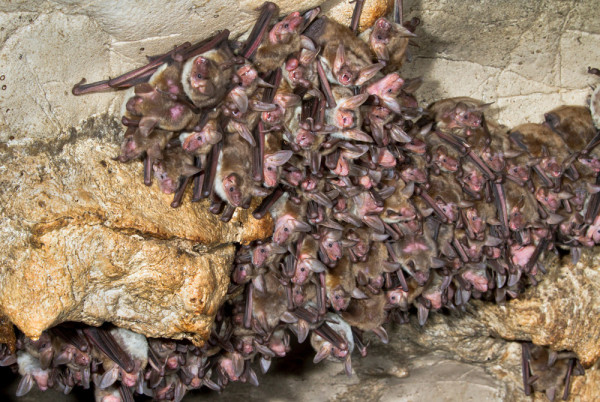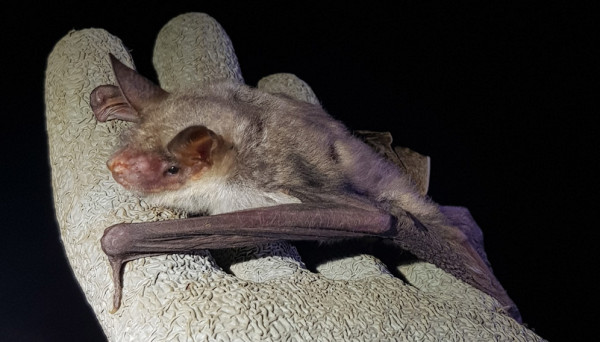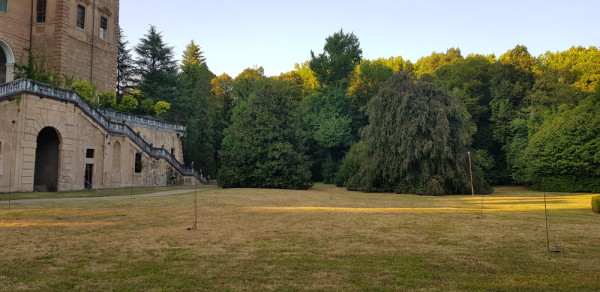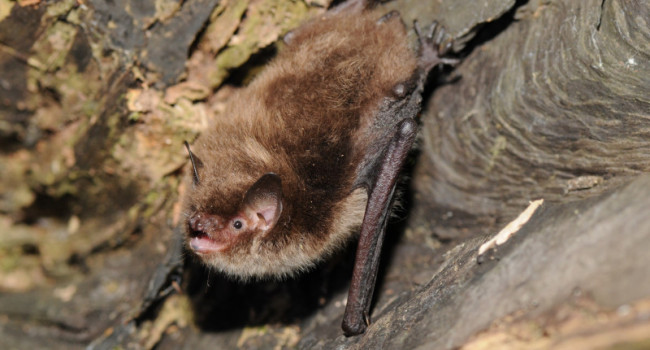
BTO goes batty: how our Acoustic Pipeline project is contributing to bat conservation in some of Europe’s most threatened landscapes
Stuart Newson is a Senior Research Ecologist in the Data Science and Bioacoustics team, where he is mainly involved in survey design and analyses of data from large national citizen science surveys.
Relates to projects
What happens when a landscape restoration programme and an innovative sound analysis project come together? Supported by the Endangered Landscapes Programme, scientists using the BTO Acoustic Pipeline to support biodiversity monitoring are making some amazing discoveries - and solving some cryptic puzzles.
What is passive acoustic monitoring?
With game-changing improvements in acoustic sensors, passive acoustic monitoring (PAM) has increased exponentially over the last few years. ‘Passive’ monitoring refers to surveys which don’t require researchers or volunteers to be out for the whole time in the field recording the species; rather, the monitoring involves setting up a recording device that automatically captures sound recordings, which can be analysed later using specially designed software.
PAM can be incredibly useful for monitoring biodiversity when species are hard to survey using traditional approaches - for example, if they are nocturnal, or live in inaccessible habitats or geographical areas. However, development in this field has not been without its challenges. In order for PAM to be an effective monitoring tool, it’s vital that the software and algorithms involved can identify species from sound as accurately and reliably as possible. However, because the sounds produced by animals are so diverse, varying within and between species, the task of ‘training’ algorithms to identify species can be very tricky. It’s made additionally challenging as the variation in signals for many species is poorly understood.
The BTO Acoustic Pipeline is the result of a decade of work at BTO focused on building machine-learning algorithms to automatically identify species across a range of species groups, from birds and bats to moths and small mammals. The focus on species identification means it’s an ideal tool to support the Endangered Landscapes Programme (ELP), which funds a suite of projects across Europe aiming to restore ecosystems and make them more resilient to environmental change. How are the two related? PAM is a great way to reveal which species are present in an area and to monitor population changes before, during and after restoration work, which is vital for deciding how best to manage a restoration site. This is particularly true at the landscape scale of the ELP projects, when PAM’s strengths for remote monitoring really come into their own.
Acoustic monitoring and spectrograms
A spectrogram is a visual representation of a bioacoustic signal: a sound's frequency (pitch) and amplitude (volume), and how these change over time. Some spectrogram 'fingerprints' are unique to a species, so can be used to identify which species made the sound.
The Acoustic Pipeline in action
Through the ELP, BTO has been supporting acoustic projects in countries as diverse as Scotland, Portugal, Romania and Georgia, where researchers have used sound recorders to sample nocturnal ‘soundscapes’ - the term used to describe all the biological and non-biological sounds of the night. These recorders can be set up to record the sounds produced by a range of animals - not only the calls of birds and small mammals, but also the sounds made by bats and even some insects.
These surveys have generated millions of recordings - an amazing dataset, but one far too large for a person to sift through manually. This is where the BTO Acoustic Pipeline comes in: cutting-edge algorithms which automatically identify species within the recordings, mining these large datasets to generate valuable new information about species and their activity within the restoration sites.
There have already been some fascinating results, such as the rediscovery of Eurasian Eagle-Owls in the Greater Côa Valley in Portugal. These owls hadn’t been detected in the valley for many years, and there were fears that a recently established Griffon Vulture colony might have displaced them. But when our colleagues at Rewilding Portugal sent us recordings from their passive acoustic monitoring in the valley, the Acoustic Pipeline’s bird classifiers were able to identify the calls of Eurasian Eagle-Owls within them.
This was particularly satisfying as detecting the owls did not mean resorting to 'playback' techniques, which use sound recordings to mimic an 'intruder' in a bird's territory. This elicits territorial calling from real birds in the area, allowing us to detect their presence. Responding to a territorial threat can be stressful, though, so avoiding playback techniques means we also avoided any unnecessary energy costs for these birds.
But discoveries are also being made for an even more elusive group of species: bats.
Bats are particularly difficult to monitor because most are nocturnal, wide-ranging and they can be difficult to identify.
BTO and bats: solving a cryptic puzzle

Over the past ten years, BTO has been developing knowledge and techniques to identify many of the 46 European bat species by sound. As a group, bats are particularly difficult to monitor because most are nocturnal, wide-ranging and can be difficult to identify. Potentially, the European bat species that need the most conservation and monitoring work now are some of the most poorly known and challenging species to study.
Funding from the ELP made it possible for us to hone in on some of these species. As a result, we have been able to conduct essential research into the calls of Lesser Mouse-eared Bat, Greater Mouse-eared Bat and the (appropriately named) Cryptic Myotis. Currently, there are no good criteria for distinguishing the calls of the Lesser Mouse-eared Bat from those of the closely related Greater Mouse-eared Bat, a task made even more difficult by the fact that these species also form mixed colonies. This means recordings from a colony will likely contain calls from several bats, with no way of knowing which call came from which species. Cryptic Myotis was overlooked completely until about ten years ago, when genetic work confirmed its existence as a species distinct from the closely related Natterer’s Bat.
To work on Cryptic Myotis and Lesser Mouse-eared Bat, we needed to collect many hundreds of recordings to capture the huge variation in calls that the bats produce. Bats use echolocation calls to navigate through their environment and find food, but also make social calls to communicate with each other as well as feeding ‘buzzes’, which are produced during the final moments of an attack on their prey.
Using spectrograms to distinguish bats
Spectrograms are useful for exploring differences in the calls between Greater Mouse-eared Bats, Lesser Mouse-eared Bats and Cryptic Myotis.

To gather these recordings, local knowledge and help are essential in making sure that recordings are from the target species, rather than any other species of bats that may be present at the same time.
In July, BTO’s Stuart Newson spent several days working with Fabrizio Gili from the University of Turin, and bat worker colleagues Elena Patriarca and Paolo Debernardi.
The team used harp traps to safely catch and identify bats from a 9th-century hill fort colony known to be home to over 600 Lesser Mouse-eared Bats and a smaller number of Cryptic Myotis.
Identifying the bats in the hand confirmed that it was unlikely that Greater Mouse-eared Bats were present in the colony, meaning that the team could be reasonably confident that any calls recorded would belong to either Lesser Mouse-eared Bat or Cryptic Myotis.


The team set up static bat detectors along routes the bats were likely to use when entering or exiting the roost, to collect recordings of free-flying Lesser Mouse-eared Bats which could later be used to train algorithms how to distinguish this species from the Greater Mouse-eared Bat.
A month later, we updated the BTO Acoustic Pipeline algorithms to include the new sound data for Lesser Mouse-eared Bat and Cryptic Myotis. The Pipeline can now start to identify these species, making it possible for future ELP projects to monitor how their restoration activities might be helping these threatened species recover in degraded habitats.
Thanks to the ELP work and help from folk in Italy and Greece, there are now just six priority bat species in Europe still requiring sound identification research (excluding a small number of island endemics) - but these, of course, remain some of the most challenging.
There are still cryptic puzzles to solve.
The work described in this blog was undertaken by Stuart Newson (BTO) in collaboration with Fabrizio Gili (University of Turin), and Elena Patriarca and Paolo Debernardi. It was supported by the Endangered Landscapes Programme, and managed by the Cambridge Conservation Initiative in partnership with Arcadia, a charitable fund of Lisbet Rausing and Peter Baldwin.

The BTO Acoustic Pipeline
brings cutting-edge sound identification software to users' desktops, and is used in several key bioacoustic monitoring projects. Photo: Paul Colley












Share this page